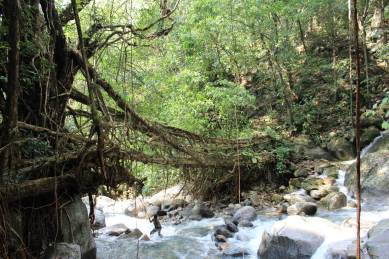Bridges Across Forever: Crowdfunding Meghalaya’s living-root bridges
An American man’s ongoing crowdfunded initiative to map Meghalaya’s living-root bridges.

It’s always a Catch 22 with travel. One discovers a place, tells people about it. People visit, tell other people about it. Over time, the discovery becomes a “tourist hotspot”, and nothing is sacred anymore. Meghalaya’s living-root bridges, which barely surfaced in popular imagination until a decade ago, is flirting with the dark side. In recent years, as hordes of tourists stand over its gnarled roots, the weight of tourism hangs heavy over these heritage bridges.
When the root bridges were first conceived by the Khasis centuries ago, it was a purely practical need: to cross turbulent streams and rivers during the monsoons. The villagers began training roots of the Indian fig trees (Ficus elastica), found in abundance in the area, to grow laterally across a stream bed, resulting in a living, breathing bridge of roots.
monthly limit of free stories.
with an Express account.
In 2015, Rodgers, 32, returned to India looking for answers to some pertinent questions such as the number of bridges that exist, how they were made, if they are still being made, and are they dying? He started a GoFundMe project online to help trace them and work towards their preservation. Over the next few months, he also met with the village headmen, made friends with the locals and started mapping the bridges. “There was a huge disconnect between the amount of information online and the actual practice,” he says during a Skype interview.
In the three years, Rodgers has mapped close to 90 bridges across East Khasi Hills and West Jaintia Hills, and has unearthed some interesting facts about the number and varieties of bridges that exist. “I have also managed to locate other varieties of living architecture: living root ladders, observation platforms, retaining walls, etc.,” he says. There’s also evidence that these bridges aren’t mere structures the villagers created centuries ago, but ones that are actively grown even today. “The general picture is one of decline, but there is evidence of new construction in Nongriat and Pyrnusula,” he says. The time required to train the roots of the bridges, usually perceived to be 15 years or more, can also vary. “Saying that they take 15 years is an over simplification. Some might take a few years, some might take longer, and some are made useable immediately by the creation of hybrid traditional material structures,” says Rodgers.
A few months into his project, Rodgers had found himself in the middle of a controversy. A Facebook post by a certain James Perry questioned his intentions and brought up larger issues about tourism in Meghalaya. Do people really need to find out about more of these bridges? Does mapping them make them lose their sanctity? In the last 10 years, the tourism department statistics show how inflow has doubled from 4.04 lakh in 2006 to 8.39 lakh in 2016. Rodgers says his only goal in mapping them is to help preseve them. “In tourist zones, the locals have an immediate economic incentive for preserving the bridges, given that the structures have become an attraction,” he says. In remoter areas, the bridges, if spoiled by natural factors, are left to perish. “The fact is that the only people who can truly save the bridges are people who live there. My hope is that compiling this information will help towards that ultimate goal,” he says.